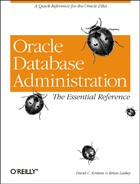The Starter Database
On most Oracle platforms, when you install the Oracle software you are given an option to create an initial or starter database, which normally consists of:
Default database name (usually ORCL)
Default database blocksize (usually 2048)
A SYSTEM tablespace
A USERS tablespace
Users SYS, SYSTEM, and SCOTT
Three online redo log files
A single control file
A single non-SYSTEM rollback segment
A standard initialization file (generally referred to as INIT.ORA in this book)
The sizes and locations of the files associated with this initial database vary from platform to platform. For all but the most simplistic database application, we strongly recommend that the starter database not be installed. Rather, you should carefully plan the database installation and create the database according to that plan. We recommend against using the starter database for the following reasons:
The database should be meaningfully named.
The default blocksize is usually too small.
The operating system file locations do not follow the Optimal Flexible Architecture (OFA), described in the next section.
The initial file sizes are usually inadequate.
Users are created with inappropriate DEFAULT and TEMP tablespace assignments.
The redo log files have not been sized and are not located properly.
Multiple (mirrored) control files should always be used to protect against damage or loss.
Multiple rollback segments should be defined in a non-SYSTEM tablespace.
Initialization parameters should be planned and tuned for the database.
While it is certainly possible for the DBA to allow Oracle to create an initial database and then make appropriate modifications, it is far more efficient and less complex and time-consuming to create the appropriate database from scratch.
Tip
Some implementations of Oracle may not give you a choice regarding the installation of the starter database. In this case, you can either modify it after creation to meet your needs, or delete it after installation and create your own database.
A sample script for creating a database is included at the end of this chapter. Note that this script is for example purposes only and, as such, is probably more simplistic than the script you’d use to create an actual production database.
